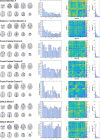Functional connectivity of cognition-related brain networks in adults with fetal alcohol syndrome
- PMID: 38093292
- PMCID: PMC10720228
- DOI: 10.1186/s12916-023-03208-8
Functional connectivity of cognition-related brain networks in adults with fetal alcohol syndrome
Abstract
Background: Fetal alcohol syndrome (FAS) can result in cognitive dysfunction. Cognitive functions affected are subserved by few functional brain networks. Functional connectivity (FC) in these networks can be assessed with resting-state functional MRI (rs-fMRI). Alterations of FC have been reported in children and adolescents prenatally exposed to alcohol. Previous reports varied substantially regarding the exact nature of findings. The purpose of this study was to assess FC of cognition-related networks in young adults with FAS.
Methods: Cross-sectional rs-fMRI study in participants with FAS (n = 39, age: 20.9 ± 3.4 years) and healthy participants without prenatal alcohol exposure (n = 44, age: 22.2 ± 3.4 years). FC was calculated as correlation between cortical regions in ten cognition-related sub-networks. Subsequent modelling of overall FC was based on linear models comparing FC between FAS and controls. Results were subjected to a hierarchical statistical testing approach, first determining whether there is any alteration of FC in FAS in the full cognitive connectome, subsequently resolving these findings to the level of either FC within each network or between networks based on the Higher Criticism (HC) approach for detecting rare and weak effects in high-dimensional data. Finally, group differences in single connections were assessed using conventional multiple-comparison correction. In an additional exploratory analysis, dynamic FC states were assessed.
Results: Comparing FAS participants with controls, we observed altered FC of cognition-related brain regions globally, within 7 out of 10 networks, and between networks employing the HC statistic. This was most obvious in attention-related network components. Findings also spanned across subcomponents of the fronto-parietal control and default mode networks. None of the single FC alterations within these networks yielded statistical significance in the conventional high-resolution analysis. The exploratory time-resolved FC analysis did not show significant group differences of dynamic FC states.
Conclusions: FC in cognition-related networks was altered in adults with FAS. Effects were widely distributed across networks, potentially reflecting the diversity of cognitive deficits in FAS. However, no altered single connections could be determined in the most detailed analysis level. Findings were pronounced in networks in line with attentional deficits previously reported.
Keywords: Connectivity; Executive functions; Fetal alcohol syndrome; Higher criticism; Prenatal alcohol; Resting-state fMRI.
© 2023. The Author(s).
Conflict of interest statement
Christian Mathys: consulting and lecturing for Siemens on behalf of the employer (Evangelisches Krankenhaus Oldenburg). The other authors declare that they have no competing interests.
Figures




References
-
- Kodituwakku P, Coriale G, Fiorentino D, Aragon AS, Kalberg WO, Buckley D, Gossage JP, Ceccanti M, May PA. Neurobehavioral characteristics of children with fetal alcohol spectrum disorders in communities from Italy: Preliminary results. Alcohol Clin Exp Res. 2006;30(9):1551–1561. doi: 10.1111/j.1530-0277.2006.00187.x. - DOI - PubMed
Publication types
MeSH terms
LinkOut - more resources
Full Text Sources
Medical
Research Materials
Miscellaneous

